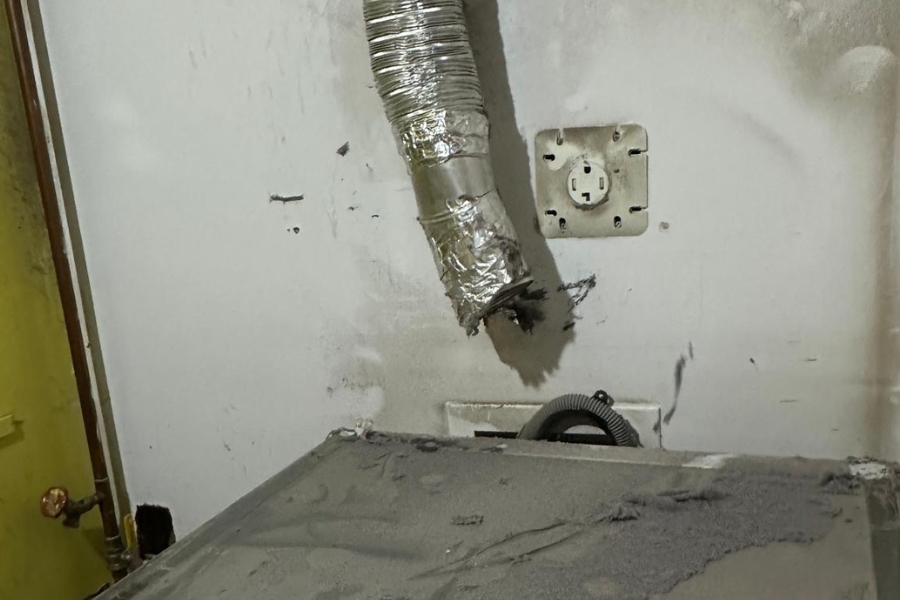While it’s best to contact a professional to replace your dryer vent hose, it’s possible for you to do it on your own!
We get it! Over time, lint, dust, and small cracks or rips can block productive airflow and stop your dryer from performing at its best. That’s why you want to fix it ASAP at the lowest possible cost. With the right tools, this is more than possible, but we highly recommend getting us on board if you’re not 100% confident in your ability to perform this operation safely!
Tools and Materials You’ll Need to Replace Your Dryer Vent Hose
Before you start, make sure you’ve got the right tools. Most of these are easy to find at hardware stores:
- New dryer vent hose (flexible aluminum or semi-rigid metal is best)
- Screwdriver or nut driver
- Foil duct tape (not regular duct tape!)
- Vent clamps or worm gear clamps
- Vacuum or lint brush
- Scissors or utility knife
If you don’t already have some of these tools, especially a nut driver or specialized clamp pliers, it might be worth calling an dryer repair specialist in Charlotte who already has the right gear to make the job faster and safer.
How To Change Your Drying Machine’s Vent Hose
Step 1: Unplug Your Drying Machine
Safety first! Always unplug your dryer before doing any work. If you have a gas dryer, turn off the gas supply as well. This guarantees you won’t risk electrical shock or accidental gas leaks.
Step 2: Pull the Dryer Away From the Wall
You’ll need space to work behind your dryer. Gently pull it forward about one to two feet. Be careful not to yank too hard; the old hose may still be connected to both the dryer and the wall vent.
Step 3: Loosen the Old Hose Clamps
Look for the metal clamps holding the hose in place at both ends (dryer and wall). Using a screwdriver or nut driver, loosen the screws on the clamps. Once they’re loose, gently slide the hose off both ends.
Check the old hose for lint buildup or tears. A thick layer of lint means your vent hasn’t been cleaned in a while and could be blocking airflow. If you see a lot of buildup, it’s a good reminder to clean your dryer vent every 3 to 6 months to keep things running safely.
Step 4: Clean the Vent Duct and Connection Points
This step is often skipped, but it’s one of the most important. Use a vacuum with a hose attachment or a vent cleaning brush to gently remove lint from the duct inside the wall. Also, vacuum around the dryer outlet before attaching the new hose.
This helps prevent airflow blockages that make your dryer work harder, waste energy, and increase the risk of overheating or even fires.

Step 5: Attach the New Drying Machine Vent Hose
Now it’s time to install your new hose:
- Slide one end of the new hose over the dryer’s exhaust vent.
- Secure it with a clamp and tighten the screw snugly (not too tight, otherwise you’ll crush the vent).
- Connect the other end to the wall vent and secure it the same way.
- For extra sealing, wrap foil duct tape around the connection points to prevent leaks.
- Avoid using plastic hoses or regular duct tape, they can melt or become fire hazards.

Step 6: Push the Dryer Back Into Place
Carefully move your dryer back toward the wall, making sure you don’t crush or kink the new hose. A bent vent hose restricts airflow and can undo all your hard work. Leave a few inches of space between the dryer and the wall for ventilation.
Step 7: Test It Out
Plug your dryer back in and run it on a short, warm cycle. Go outside and check that air is blowing out of the exterior vent flap. If you live in a home, it’s usually located on an outside wall of your house. If you feel strong airflow, you’ve done it right! If the flap isn’t moving or you hear strange rattling, double-check the hose connections.
If you live in an apartment and can’t access the exterior vent, you can test airflow at the vent opening inside your unit. Run the dryer on a short, warm cycle and feel for strong air coming out. Weak airflow could mean the vent needs cleaning or professional inspection.

When to Call a Professional To Replace Your Dryer Vent Hose
If your dryer vent runs through walls, ceilings, or has multiple turns, replacing it yourself will be trickier than we make it sound! Just Call can provide professional appliance repair while using specialized tools like vent cameras, dryer vent brushes, and airflow meters to handle the more complex setups.
You should also call for help if:
- You can’t access the wall vent safely.
- You have a gas dryer and notice a gas smell.
- The vent hose runs long distances or through the attic.
In these cases, you’re not only saving yourself from a potential hassle, you’re also guaranteeing your safety. While it may be more affordable to complete the vent hose replacement on your own, you can protect your peace of mind by allowing us to handle it according to North Carolina’s fire code!
